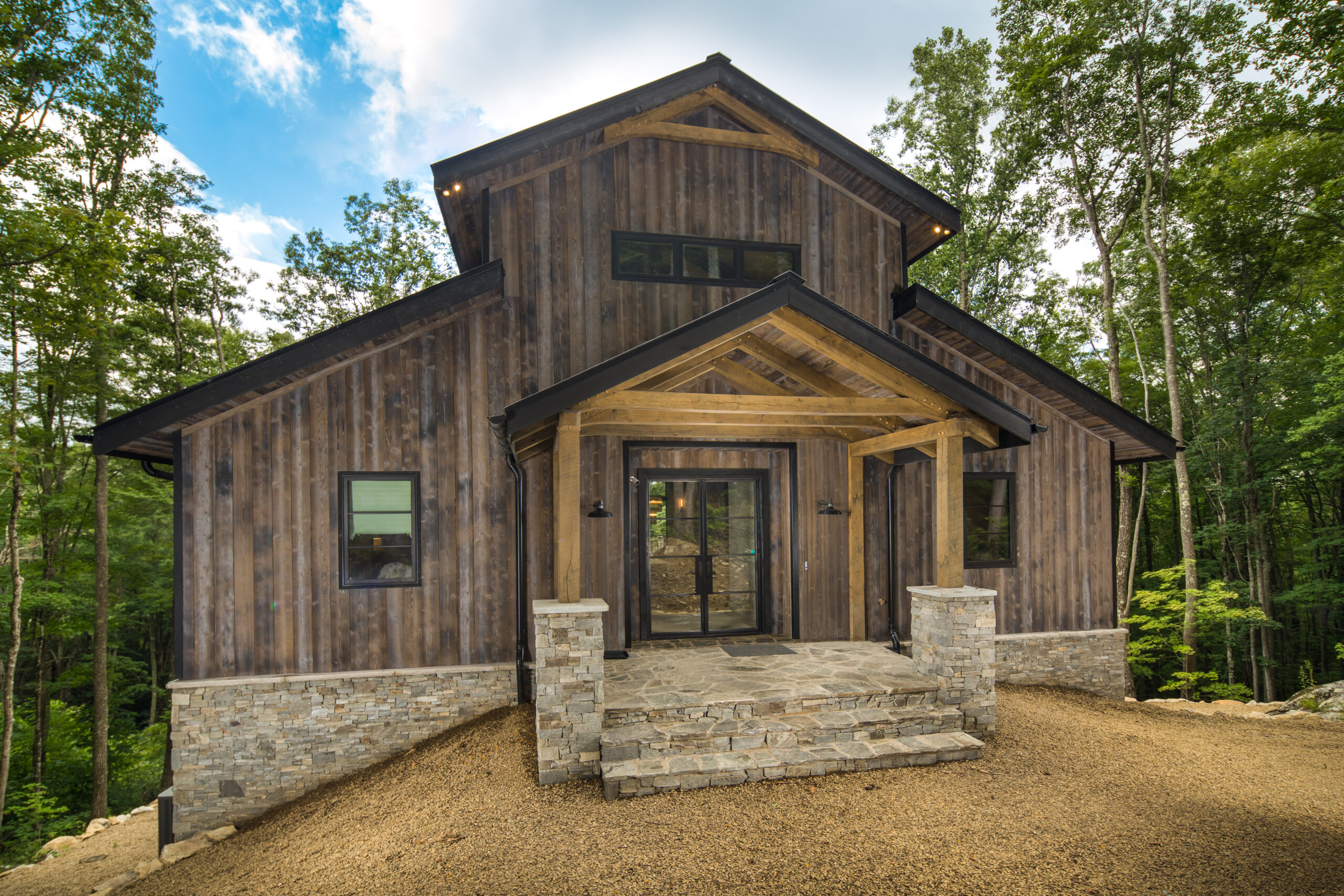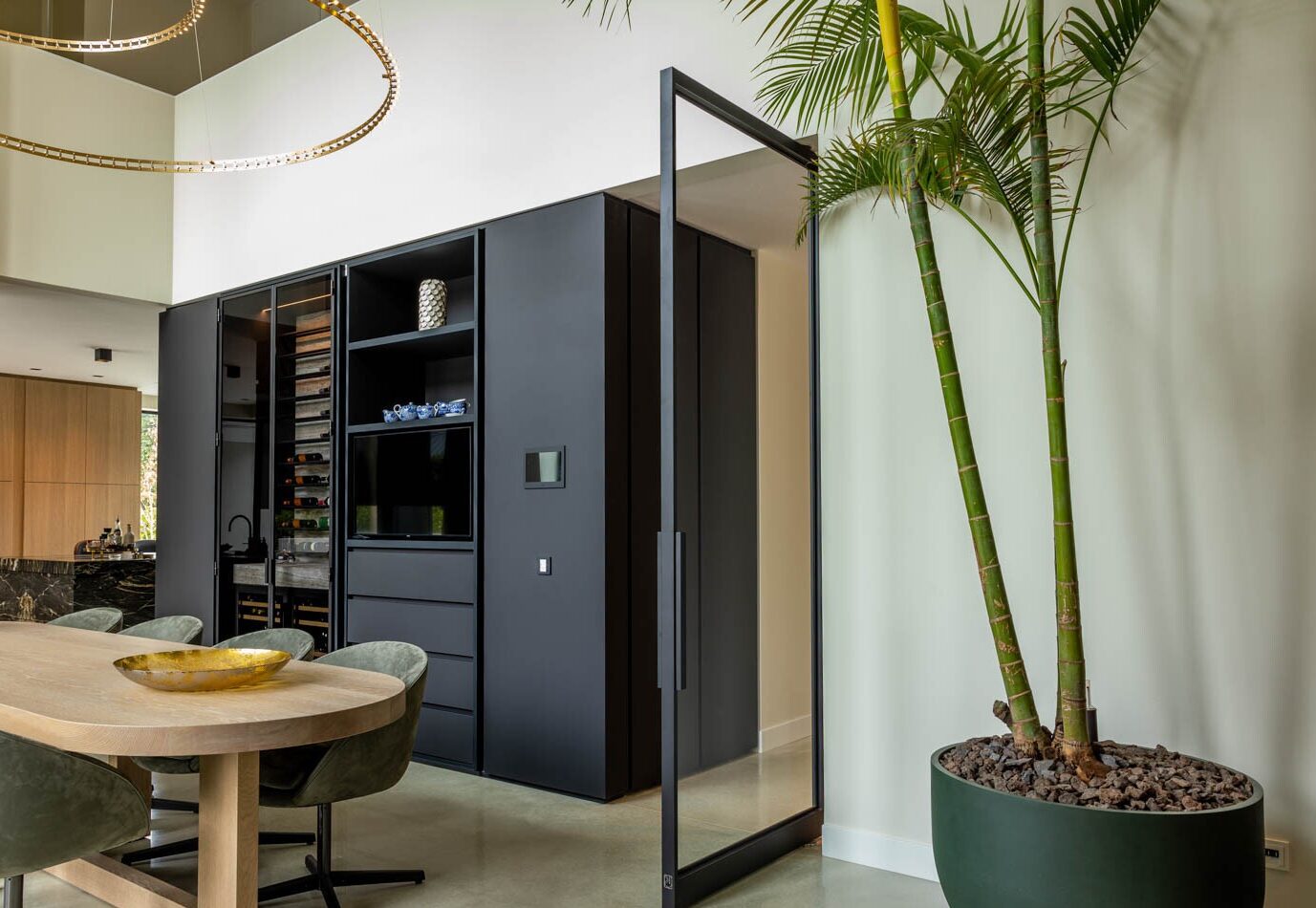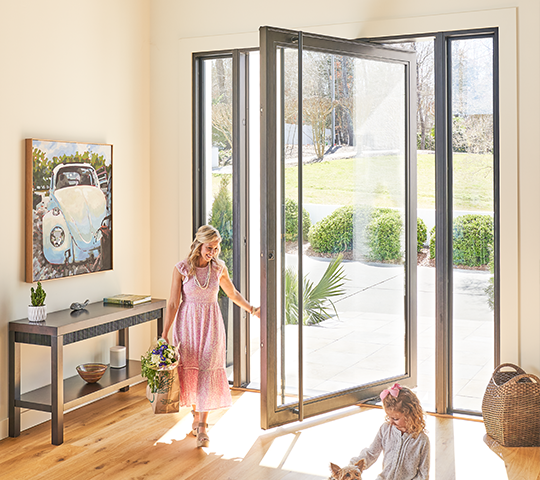At Clark Hall, we believe your front door should be more than just a functional part of your home — it should reflect your home’s character, welcome your guests, and stand the test of time. If you’re considering a front door replacement, it’s essential to understand the full cost picture before you select the style, material, and finish.
In typical installations across our East Coast service area, front door replacement costs range from approximately $1,000 to $6,000, depending on size, material, design complexity, and installation requirements.
Understanding the Costs
Replacing your front door involves more than just picking a style; it’s about balancing cost, material, and design to find the perfect fit for your home and budget. Let’s break down all the factors to help you make an informed decision.
Key Factors Influencing Replacement Cost
Before replacing or updating your front door, take into account all the factors that will impact the total cost of the replacement.
Door Material
The material you choose for your front door is a major factor in the overall cost. Wood doors offer a classic, warm aesthetic and natural insulation, but they can be prone to warping. Aluminum and fiberglass doors are lightweight, resistant to rust, and usually cost-effective.
Custom iron doors, such as those from Clark Hall, are typically more expensive than other materials due to their intricate designs, durability, and the premium craftsmanship involved in their production. These exterior doors not only offer superior strength and security but also add a distinctive, luxurious touch to your home’s entrance.
Door Style and Design
Simple, traditional styles tend to be more affordable, while doors featuring decorative glass inserts, custom carvings, or unique architectural details can quickly increase the price. Custom designs, such as those tailored to fit non-standard openings or created to match specific aesthetic preferences, typically come at a premium.
Additionally, doors with added features like sidelights or transoms, which enhance the visual appeal and allow more natural light, will also raise the overall cost.
Hardware, Accessories, and Add-On Costs
Hardware and accessories may seem like finishing touches, but they play a critical role in how your entry door looks, feels, and performs. High-quality handles, hinges, and locks ensure lasting durability and reliable security, while decorative details such as knockers, mail slots, and custom house numbers bring personality and curb appeal to your home’s façade.
Additional elements such as sidelights and transoms can dramatically enhance the look of your entryway and increase natural light, but they also raise material and installation costs. These glass features require custom framing and precise installation to maintain structural integrity and energy efficiency.
Finally, details like reinforced jambs and upgraded sills add to the investment but help prevent drafts, improve durability, and create a solid seal that keeps your home comfortable year-round. Though these add-on costs can vary, they often make the difference between a standard entry and one that feels truly custom.
Want more front door pricing information for your home? Contact us today for a custom quote.
Labor and Installation Fees
The cost of installation can vary depending on the complexity of the job, such as whether you’re replacing just the door or the entire frame, or if custom adjustments are needed. While it might be tempting to save on costs with a DIY approach, professional installation is often worth the investment to avoid issues down the line.
For added convenience and peace of mind, Clark Hall door offers installation on most of the East Coast and shipping elsewhere is also available. We also offer a comprehensive product warranty, ensuring your door remains protected and performs beautifully for years to come.
Geographic Location
In areas with a high cost of living, such as major cities or affluent suburbs, both the price of materials and the cost of labor are typically higher. Regional factors like climate and weather conditions also might influence the type of door you need, potentially affecting the overall cost.
For instance, doors in more humid conditions like coastal homes might need to be installed with additional weatherproofing and corrosion-resistant hardware to ensure durability and prevent damage from moisture. Additionally, local building codes and regulations may require other features or modifications, like an additional finish to prevent rusting in the salt air. Or, for colder climates, they may need to be thermally broken to prevent the door from sweating when cold on the exterior and warm on the interior.
Pre-Hung vs Slab Doors
A pre-hung door comes as a complete unit with its own frame, hinges, and hardware pre-installed, making it the most convenient option for full replacements or when the existing frame is damaged. Though pre-hung systems tend to cost more upfront, they simplify installation and ensure a precise, weather-tight fit — often saving on labor and future maintenance.
A slab door, by contrast, is just the door panel itself. It’s typically less expensive, but requires careful alignment with an existing frame and professional carpentry to fit correctly. If the frame is uneven, damaged, or out of square, those adjustments can offset any initial savings.
Door Size and Structural Modifications
Your front door’s size and the surrounding structure directly affect total replacement costs. Standard single doors are typically the most budget-friendly, while oversized or double-door configurations often require additional framing, reinforced hinges, and custom hardware.
If your new design calls for widening an entryway, adding sidelights, or modifying the header, those structural changes increase both material and labor costs. Custom sizing also extends fabrication time, especially for handcrafted materials like wood or iron, which are built to exact measurements.
Old Door Removal and Disposal Fees
Removing an existing door might seem simple, but it can involve more work than expected. Installers often need to remove old trim, frames, and threshold materials before the new system can be installed. Most professional installations include removal and disposal, but some services may charge between $50 and $200, depending on door size, weight, and local disposal requirements.
For heavier materials, like iron or steel, disposal can cost slightly more due to recycling or transportation fees. Working with a full-service provider like Clark Hall ensures these details are handled cleanly and responsibly, leaving your entryway ready for its new installation.
Additional Costs to Consider
A new front door is a lasting investment, and small details can make a noticeable difference in both cost and craftsmanship.
Custom touches, like hand-forged ironwork, glass panels, or a unique finish, often add to the price but elevate the overall look and feel of your home. These design choices take more time and skill, yet they’re what make an entryway truly stand out.
Upgrades that improve performance — such as insulated glass, thermal breaks, or reinforced frames — can also increase cost slightly while enhancing comfort and security. Clark Hall doors are built with these features in mind, blending durability with timeless design.
It’s also worth factoring in warranty coverage and ongoing maintenance. Materials like wood or iron may need occasional refinishing, while fiberglass or steel are lower-maintenance. Choosing a door backed by Clark Hall’s product protection and support ensures it continues to perform beautifully for years to come.
Comparing Different Front Door Materials
Choosing the right front door material is essential for balancing aesthetics, durability, and cost. This section compares various materials to help you find the best option for your needs and preferences.
Wood Doors
Wooden doors offer timeless appeal and natural insulation, making them a popular choice for homeowners seeking both beauty and functionality. However, they typically come at a higher price compared to other materials, with costs varying based on the type of wood and craftsmanship.
They are also prone to issues like warping, swelling, and damage from moisture if not properly maintained. If your home gets a lot of sun exposure, the wood door is more prone to dry out. This causes issues like refinishing upkeep. Despite these challenges, many homeowners appreciate the classic look and feel of a wooden door, viewing it as a worthwhile investment for its durability and style.
Steel Doors
Steel doors are valued for their strength, security, and durability. They offer superior protection against forced entry and are resistant to warping, cracking, and denting, making them a practical choice for high-traffic areas and home entryways.
Additionally, steel doors often come with energy-efficient core materials that can help with insulation. Although they are less prone to damage, steel doors can be prone to rust if the protective coating is compromised, so proper maintenance is essential to ensure longevity.
Fiberglass Doors
Fiberglass doors offer a blend of durability, low maintenance, and aesthetic versatility. They are resistant to warping and denting, making them a practical choice for varying weather conditions. Fiberglass doors can mimic the look of wood while providing better insulation and energy efficiency.
They are generally more affordable than high-end wooden doors and often cost less than steel doors, especially when considering long-term maintenance. While they might not match the premium feel of solid wood, their resistance to the elements and ease of upkeep makes them a cost-effective and attractive option for many homeowners.
Aluminum Doors
Aluminum doors are known for their lightweight nature, resistance to rust, and low maintenance requirements. They are a cost-effective option, typically priced lower than high-quality wood and steel doors, and they offer good durability and resistance to the elements. Aluminum doors are also customizable and can be finished in various colors and textures.
However, they may not provide the same level of insulation as fiberglass or wood doors and can be less resistant to dents and impacts compared to steel. While generally affordable, the cost can vary based on design features and finishes, making them a versatile choice for a wide range of budgets and preferences.
Installation Services
Installing a front door involves more than simply placing a new door on its hinges. Your front entry may require structural modifications to fit a new door, or the area may require additional features like new trim or weatherstripping.
For these reasons, we recommend having your new Clark Hall front door installed by a local team. Our professional installation teams are familiar with all of our front door styles and materials, and they can ensure your new door performs optimally and lasts longer.
Contact us to see if we have a local installation team near you to take care of the entire process for you and to help you avoid any unnecessary extra costs.
Planning Your Front Door Replacement: Timeline, Lead Times, and Financing
From your first idea to final installation, our goal at Clark Hall is to make the replacement process as simple and transparent as possible.
Because each door is made to order, timing depends on the design and scope of your project. After your consultation and design approval, we’ll create a detailed CAD drawing for review. Once approved, fabrication begins. Most custom doors take several weeks to complete, as each piece is handcrafted and finished with care. Your design consultant will keep you updated throughout every step — from fabrication and shipping to professional installation.
To help your project stay on track, confirm your final measurements, hardware choices, and finish selections well in advance. Clearing space around the entryway before installation day also helps ensure a smooth process once your door arrives.
We understand that a custom door is a significant investment. To make the process easier, financing and staged payment options are available, and your Clark Hall representative can guide you through them in detail. Our team is here to help you plan confidently and enjoy the experience of creating a door that’s truly one of a kind.
When Is the Best Time to Replace Your Front Door?
Optimal timing depends on seasonal factors and local weather conditions. If you notice issues with your front door and have considered replacing it, please contact us for a quote to get your process underway.
Benefits of Upgrading Your Front Door
Upgrading your front door is one of the simplest and most impactful ways to improve your home’s curb appeal. A well-built door not only elevates the look of your entryway, but also provides better insulation, improved security, and increased comfort. Modern materials combined with advanced weather-sealing help maintain steady indoor temperatures, reducing energy costs year-round.
It’s also a smart investment. Beyond refreshing your home’s exterior, a high-quality, thoughtfully designed entry can deliver one of the highest returns on investment among home improvement projects. When style and craftsmanship are prioritized, your new door becomes more than functional — it becomes a statement piece that reflects attention to detail and lasting value.
You can explore more about how front door replacements compare to other high-ROI home improvements in our homeowner guide.
Budgeting For Your Front Door Replacement
As we’ve covered, setting a realistic budget for your front door replacement involves evaluating both your financial constraints and the features you desire. Start by determining how much you can comfortably spend, taking into account the cost of the door itself, installation fees, and any additional expenses for hardware or modifications.
Be sure to include a buffer for unexpected costs that might arise during the project, such as structural adjustments or unforeseen repairs. By planning thoroughly and understanding all potential expenses, you can achieve a balance between your budget and your ideal front door. And, updating your front door adds significant value to your home for years to come.
Choosing Your Front Door Investment
A front door sets the tone for your entire home. It’s the first impression, the daily welcome, and a reflection of the care you’ve put into your space. At Clark Hall, we help homeowners turn that vision into something tangible — a custom door that balances beauty, strength, and long-term value. From design to installation, our team manages every detail with precision and care.
Our turnkey process makes it simple to bring your design to life. We’ll guide you through material and finish selections, provide detailed CAD drawings for approval, and coordinate professional installation once your door is complete. The result is a handcrafted entryway that elevates your home’s character and stands the test of time.
Frequently Asked Questions
When is the best time to replace your front door?
The best time to replace your front door is when the weather is mild and humidity levels are stable, typically spring or early fall. These conditions allow for easier installation and proper sealing. If your door sticks, lets in drafts, or shows visible wear, it may be time to start the process. Reach out to our team at Clark Hall for a consultation and custom quote to get started.
How much should you spend on a new front door?
Front door replacement costs can vary widely depending on the material, style, and any additional features. The key is to find a door that fits both your financial plan and the aesthetic you want for your home. Whether you prioritize security, durability, or curb appeal, there’s a wide range of options available to suit various needs and budgets.
What factors influence the cost of front door replacement?
Several key factors shape overall cost:
- Door material and construction quality
- Style, size, and custom design elements
- Hardware, accessories, and add-on features
- Labor and installation requirements
- Geographic location and permitting needs
How long does front door installation take?
Most front door installations can be completed in a single day once fabrication is finished. Custom projects that include sidelights, transoms, or structural adjustments may take slightly longer. Your Clark Hall team will confirm the timeline in advance so you’ll know exactly what to expect.
Can I replace my front door without replacing the frame?
In some cases, yes — if the existing frame is in good condition and properly aligned. However, for older homes or when upgrading to a custom size, replacing the frame ensures a better fit, improved insulation, and long-term performance. Clark Hall’s experts can evaluate your entryway and recommend the best approach.
Are there rebates or tax credits for energy-efficient front doors?
Some energy-efficient doors may qualify for federal tax credits or local utility rebates, depending on where you live. Many Clark Hall doors are built with insulated cores and energy-saving glass, which can contribute to lower utility costs and potential eligibility. We recommend checking current programs or consulting your installer to confirm what applies in your area.







